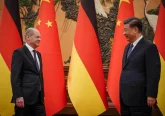 Today there is no agreement on what should replace the Kyoto Protocol (KP) expiring in 2012. What is certain, however, is that the framing of the new climate regime may create new scenarios, involving new fora and strengthening certain international players while weakening others.
Today there is no agreement on what should replace the Kyoto Protocol (KP) expiring in 2012. What is certain, however, is that the framing of the new climate regime may create new scenarios, involving new fora and strengthening certain international players while weakening others.
Since the Copenhagen Summit in 2009 (COP15), the effectiveness of the UNFCCC has been put into question, and, with it, the image of the COPs (Conferences of the Parties) as the most appropriate fora to carry out negotiations, despite their wide membership and legitimacy. Hence, some officials have started considering the necessity to find alternative fora to deal with climate change (e.g. G20, WTO), as well as the need to find new approaches. As far as the fora are concerned, this was for instance the position of some officials of the Spanish EU presidency, but was opposed by the Commissioner Hedegaard and by Runge-Metzger, EU chief climate negotiator. According to the Commissioner it would be a “waste of work”, while, more pragmatically, the EU chief negotiator argued that an agreement should be drafted in other fora and then fed into the main UN negotiations. The key, he is reported to have said, is to appear to be endorsing the UN process while still pushing for other fora to do the “heavy lifting”.
In the past China has shown some reticence in using smaller frameworks than the UN to deal with Climate Change related issues, as this would limit its bargaining power, which it has built within those wide multilateral institutions and through large coalitions such as the G77+China. Nonetheless, during a personal conversation with some Chinese officials at the Chinese delegation to the EU in April 2010, there was some openness on this point, noting that, in principle, China is willing to use smaller fora such as the G20, except that, at a later stage, the issue should be taken to the wider UN framework. This position was later confirmed in October 2010 by Xie Zhenghua, China’s Head Negotiator on Climate Change and Vice Chairman of the NDRC on occasion of the press conference to the UN Climate Talks in Tianjin, when he noted that “China is for full consultation in the UN framework but we are not against smaller consultations” in the respect of the principles of openness, transparency and full consultation. The change in China’s position can be explained by looking at what happened in Copenhagen. Despite China’s efforts to tackle climate change by setting its emission intensity target, it obtained a much colder welcome than it had expected, and it was trapped in a public diplomacy battle. The latter saw it losing face internationally because of its unwillingness to be bound by international commitments, and by its reticence to accept Monitoring Reporting and Verification measures. To avoid this to happen again, Xie Zhenghua in Tianjin proposed that issues such as MRV, the claims of small islands or the status of developing countries “Should not be put forward at international occasions” but rather be dealt with in smaller fora. These are in fact those issues that risked to divide the previously united front of developing countries and that contributed to picture China as the inflexible and non-cooperative party in the climate change negotiations.
This is certainly a very important shift in the negotiating pattern, which certainly moves China farther away from developing nations. A similar move, it reduces the risks of putting under the spotlight both the differences between China and its developing partners, as well as its limited flexibility with regards to certain aspects under negotiations (e.g. sovereignty, non interference etc).
Apart from the discussion over the necessity to find alternative fora to deal with climate change, another issue to be increasingly debated is the necessity to find a new approach to manage the overall negotiating process. Due to the evident difficulties in framing an all-encompassing climate change deal, another option is to pursue what the EU called a ‘sectoral approach’. In this vein the EU, in consultation with China, is already evaluating the possibility of drafting a ‘plan-B’ to deal with climate change, should the UN process fail. More recently Robert Falkner et al. have proposed an approach similar to the EU’s sectoral one, making the case for a ‘building block’ paradigm instead of battling for a difficulty achievable “global deal”.
It is not yet clear whether the Cancun Summit (COP16), to be held from November 29th to December 10th, will bring new cards on the table, or whether the Parties will clearly opt for a sectoral or for a comprehensive approach. What is certain is that the discussions on the definition of a binding agreement are not anymore on the agenda. At the same time, in light of the debacle of the Democrats in the mid-term elections, the US are unlikely to be in the condition to make substantial steps forwards in its negotiation position. This could further exasperate the process, which already suffered from the domestic situation in the US during the Tianjin talks held last October. Should this continue to be the case, it could be up to the EU and China to take the lead in Cancun. The EU, as it did on occasion of the Kyoto negotiations, could play a pivotal role, and become a bridge between developed, developing and emerging countries. For instance, it could openly call for a second commitment period for the KP, as asked on several occasions by the G77+China, and open the negotiations on some limited improvements. The PRC, from its side, could also make a step to facilitate the reaching of a compromise. For instance, it could ease its negotiating language with regards to the commitments of non-Annex I parties, and accept the definition of commitments also for those countries that are nor developed nor developing i.e. emerging economies (BASICS) without breaching the principle of “common but differentiated responsibility”.
The EU is already a major player in the KP, and it would benefit from an extension of the current framework as it would reassure investors by clarifying the legislative framework for the post-2012 years. This is the case, for instance, for the trade of Certified Emission Reductions (CERs). China is currently the major beneficiary from the projects under the KP, hence, it is also in its own interest to see implemented a second commitment period. In addition, by positively contributing to its entry into force, China could also claim to be a “responsible stakeholder” and it would be sheltered against any future criticism from the international community. Also, should China manage to shape the climate change regime to its favour, it could even gain an advantage vis-à-vis India, which already share with the PRC the highest number of projects under the KP’s Clean Development Mechanism. Finally, in so doing, both the EU and China would put further pressure on the US, which, even though it has the highest per/capita emissions rate among the world’s largest economies, it is still reticent to commit to fight climate change.
In conclusion, despite the low expectations and the fact that the Cancun Summit will hardly produce any legally binding text, it could still produce significant results. On the one hand it could further strengthen the role of the EU and China, which would gain in terms of status and image by fighting effectively (and responsibly) against a major global threat. On the other hand, it could further sideline the US, which, lacking domestic support, might not be in the condition to play an active role in the negotiations. While in Copenhagen the talks where distracted by the pipe dream of a brand new legally binding agreement for all, it is now clear that we need to build on what we already have.







No Comment